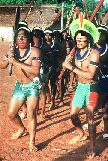Photo Gallery
INTO THE HEART OF THE AMAZON:
AMONG THE KAYAPO, 1992
from Penthouse, November 1993
© Scott Wallace
 I hopped off the bush plane at A-ukre’s airstrip amind a cluster of wailing women and painted warriors brandishing Winchester rifles. The women sobbed in Kayapo, repeating the name of their young leader, “Paiakan, Paiakan.” Scores of naked children, their bodies painted in black stripes and geometric designs, stared out from the surrounding forest.
I hopped off the bush plane at A-ukre’s airstrip amind a cluster of wailing women and painted warriors brandishing Winchester rifles. The women sobbed in Kayapo, repeating the name of their young leader, “Paiakan, Paiakan.” Scores of naked children, their bodies painted in black stripes and geometric designs, stared out from the surrounding forest.
The braves led us down a path, across the blood-red dirt of the village clearing, and into a huge open-air hut in the village center. Scores of bare-chested Indians, their faces smeared in red and black war paint, huddled cross-legged amid a thicket of clubs, arrows, and shotguns. An elderly chief stomped around the hut’s perimeter — beating his chest, thrusting his rifle into the air — as he boasted in Kayapo of his past military exploits.
Paiakan himself soon emerged from the forest with a broad black band painted across his eyes. He was wearing the same brilliant feather headdress that had framed his portrait on the cover of Veja. At his side he lugged a gleaming new 12-gauge shotgun. The son of one of A-ukre’s four elder headmen and one of the few villagers fluent in Portuguese, Paiakan was, in fact, a first among equals here; the recognition he had earned for himself and his people in the outside world had cemented his authority at home.
The federal police were threatening to invade the Kayapo reserve to capture Paiakan. Fearing a commando raid on the village, A-ukre’s warriors had blocked the airstrip with fallen trees. But on the two-way radio that linked the village to Rendencao, Paiakan had agreed to see the group of Indian rights activists I had hooked up with for the trip in. At the appointed hour, the trees were pulled from the airstrip to allow our bush plane to land
We read a grim determination beneath the paint on the assembled faces. The warriors were dimly aware of the anti-Indian vitriol building among the Brazilians beyond their rain forest homeland. No one knew if Paiakan had really done what his accusers alleged, and no one seemed to care; all perceived a common threat and closed ranks behind their leader.
anti-Indian vitriol building among the Brazilians beyond their rain forest homeland. No one knew if Paiakan had really done what his accusers alleged, and no one seemed to care; all perceived a common threat and closed ranks behind their leader.
Only one week earlier, the feds had stormed the homelands of the Guajajara further north to seize marijuana plants used in tribal ceremonies. The incident had passed without bloodshed; the Indians captured the agents, stripped them of their weapons and uniforms, and released them stark naked. But a showdown in A-ukre would have offered little chance for such comic relief.
The Kayapo have been far more successful in preserving their traditions in the midst of outside pressure than most rainforest peoples, many of which have disappeared altogether in the face of outside contact. Anthropologists attribute the Kayapo’s survival to a highly regimented village life. At puberty, boys move out of their families’ homes to live among the village chiefs and elders. They learn the arts of tracking, hunting, warfare, and the highly theatrical ceremonies that bond villagers in a solid communal identity.
They are arguably the most powerful tribe in the entire Amazon Basin. Numbering only 4,000 or so, the Kayapo have formed the core of a resistance that — in league with neighboring tribes and international environmentalists — has halted an avalanche of ranchers, loggers and miners who have already decimated a huge swath of the eastern Amazon.
 The Kayapo reserve and adjacent Indian lands embrace a treasure trove of near virgin rainforest — a defensive corridor several hundred miles in length that has, under now, eluded the grasp of rapacious developers. Which is why many believe the charges against Paiakan represented a cover for anti-Indian interests bent on cutting the Kayapo down to size and grabbing their resources.
The Kayapo reserve and adjacent Indian lands embrace a treasure trove of near virgin rainforest — a defensive corridor several hundred miles in length that has, under now, eluded the grasp of rapacious developers. Which is why many believe the charges against Paiakan represented a cover for anti-Indian interests bent on cutting the Kayapo down to size and grabbing their resources.
In fact, my inquiries had already turned up a number of disturbing contradictions in the prosecution’s case. And with so much at stake, I was beginning to wonder if I wasn’t pushing my luck. The eastern Amazon is not the kind of place where red carpets are rolled out for outsiders asking lots of nosey questions. It is the most violent region in all of Brazil — an area where environmental devastation has proceeded on a massive scale under the aegis of a clique of ranchers and loggers who maintain their grip with threats and bribes and who, more often than not, dispense justice through the barrel of a gun.